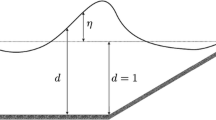Abstract
A fundamentally new mechanism of tsunami generation as a result of water discharge into rapidly opening seismic fractures of the bottom is proposed. A mathematical model of the phenomenon developed within the framework of the linear potential theory is presented. The main parameters of the problem that affect the characteristics of the formed wave are revealed.
Similar content being viewed by others
References
N. V. Shebalin, “Macroseismic Problems,” Vychislit. Seismol. No. 34, 57–200 (2003).
N. V. Shebalin and F. F. Aptikaev, “Development of MSK-Type Scales,” Vychislit. Seismol. No. 34, 210–253 (2003).
E. A. Rogozhin, A. N. Ovsyuchenko, and A. R. Geodakov, “On a Strong Earthquake in Altai,” Vestn. RFFI, No. 2 (36), 60–70 (2004).
Strong Earthquake in Altai on September 27, 2003. Materials of a Preliminary Study, Ed. by A.O. Gliko (Inst. of the Earth’s Physics, Russian Academy of Sciences, Moscow, 2004) [in Russian].
M. I. Strel’tsov, Neftegorsk Earthquake in Sakhalin on May 27 (28), 1995, Ed. by A. I. Ivashchenko, A. I. Kozhurin, and B. V. Levin (Yanus-K, Moscow, 2005) [in Russian].
Gobi-Altai Earthquake, Ed. by N. A Florensov and V. P. Solonenko (Akad. Nauk SSSR, Moscow, 1963) [in Russian].
M. Ikeya, H. Satoh, U. Ulusoy, and R. Kimura, “Split Sea and Walls of Water. Moses Phenomenon at the Izmit Earthquake, Turkey,” Proc. Jpn. Acad. B 78, 24–29 (2002).
N. E. Voltsinger and A. A. Androsov, “Modeling the Hydrodynamic Situation of the Exodus,” Izv. Akad. Nauk, Fiz. Atmos. Okeana, 39, 532–546 (2003) [Izv., Atmos. Ocean. Phys. 39, 482–496 (2003)].
M. A. Nosov and N. K. Shelkovnikov, “The Excitation of Dispersive Tsunami Waves by Piston and Membrane Floor Motions,” Izv. Akad. Nauk, Fiz. Atmos. Okeana 33, 145–151 (1997) [Izv., Atmos. Ocean. Phys. 33, 133–139 (2003)].
M. A. Nosov, “Ttsunami Generation in a Compressible Ocean by Vertical Bottom Motions,” Izv. Akad. Nauk, Fiz. Atmos. Okeana 36, 718–726 (2000) [Izv., Atmos. Ocean. Phys. 36, 661–669 (2003)].
B. W. Levin and M. A. Nosov, Physics of Tsunami and Kindred Phenomena in Ocean (“Janus-K”, Moscow, 2005) [in Russian].
M. V. Fedoryuk, Asymptotics: Integrals and Series (Nauka, Moscow, 1987) [in Russian].
Author information
Authors and Affiliations
Corresponding author
Additional information
Original Russian Text © B.W. Levin, M.A. Nosov, 2008, published in Izvestiya AN. Fizika Atmosfery i Okeana, 2008, Vol. 44, No. 1, pp. 122–126.
Rights and permissions
About this article
Cite this article
Levin, B.W., Nosov, M.A. On the possibility of tsunami formation as a result of water discharge into seismic bottom fractures. Izv. Atmos. Ocean. Phys. 44, 117–120 (2008). https://doi.org/10.1134/S0001433808010131
Received:
Published:
Issue Date:
DOI: https://doi.org/10.1134/S0001433808010131




